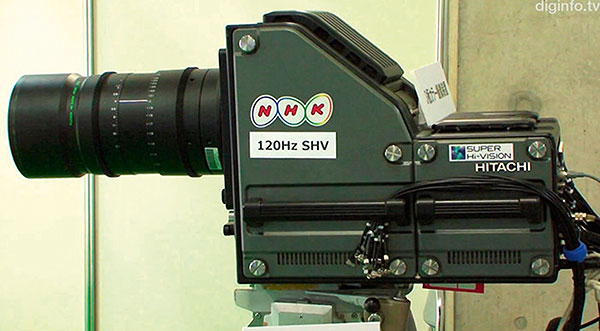
Get Ready For 4K and 8K Broadcasts (if you live in Korea or Japan)
Posted on Nov 8, 2012 by Alex Fice
NHK’s 8K camera is part of their 8K broadcast trial in Japan.
With new standards for 4K and 8K television broadcasts now ratified by the ITU the business of actually broadcasting the pictures starts. We talked with ITU’s David Wood about the next step.
When High Definition Television was first broadcast it was quite a surprise for many people in the industry even though the planning had been going on for 15 years at the ITU. The major players like the satellite companies and the broadcasters were like a line of horses waiting for the start at the Grand National, who would be first out. High Definition broadcast had been expected for so long that it’s emergence was something of a shock when it eventually happened.
It was the vision of companies like EURO 1080 back in 2004 that showed what was possible with the standard. EURO 1080 was in effect a mobile company who wanted to add momentum to higher resolution broadcast so they could be at the front of the recording of it, it was certainly a statement. German and British broadcasters then saw that a business plan would work hand in hand with the HDTV manufacturers who needed a new revenue stream as CRT sets hit a performance/size/weight limit at 37 inches.
But now the ITU’s Study Group 6 has not only ratified a standard for 4K broadcast but 8K as well, planned for a 2020 start in Japan. David Wood of the EBU and ITU explains the thinking, “The studies in the ITU take many years and begin with a proposal from a country to open a standard in a particular area. Infact the subject of Ultra High Definition was opened over ten years ago in the ITU at the suggestion of Japan and since then all the various aspects of the television system, the number of lines, pixels, colourimetry, the sampling have been the subject of discussion.”
The advances made with each of these quality steps are roughly similar to the step from the old ‘standard definition television’ to ‘high definition television (HDTV)’. HDTV pictures today have the equivalent of between 1-2 megapixels. The first level of UHDTV picture levels has the equivalent of about eight megapixels (3,840 x 2,160 image system), and the next level comes with the equivalent of about 32 megapixels (7,680 x 4,320 image system). As a shorthand way of describing them, they are sometimes called the ‘4K’ and ‘8K’ UHDTV systems.
One of the driving forces behind this standard are the HDTV manufacturers like Samsung, Sony and Panasonic. The business of selling HD flat panels isn’t the cash cow it once was as prices have levelled so a re-invention of the technology is needed as 3D also seems to be faltering. But there are also some proven social reasons for higher resolution panels that will please commercial broadcasters, David Wood, “It has been proven that the higher picture quality you have the longer you will watch the programme for. So programme makers in a sense get more value for the product. In my role at the EBU we have discussed what we call the ‘zapping point’, the point where the viewer changes channel. There was study done in France where people were shown exactly the same programme, in exactly the same viewing conditions in both SD and HD and the HD versions pushed the zapping point up around 30%. It’s probable that the same effect will happen when you introduce Ultra High Definition television 4K and then when we go up to 8K.”
These types of studies whet the appetite of consumer electronics manufacturers and broadcasters alike but once the basics of the standards have been arrived at the actual business of finding a way to transmit these pictures continues in all ways, terrestrial, by satellite, broadband and cable. There are other ITU groups for these types of decisions like the DVB project and ATSE. The ITU only lays the basis of the picture format.
Not surprisingly in Japan there has already been some terrestrial broadcasting trials with the 8K system and course there were also some 8K trials for the Olympic Games in London with public viewings in the UK, Japan and the USA. Apparently people were on their feet watching the pictures but we’re not sure whether that had something to do with the Olympics themselves. But the trials open up the question of distribution, “The data for the 32Mb picture is around 350Mbit/s whereas HD is about 12Mbit/s so its a huge step up. Of course in between HD and 8K you have the 4K system which will require less data but it’s a trade off. Next year in Korea there will be a trial of 4K terrestrial broadcasting using the DVB T2 system which is the same one as used in the UK. The hope is that by using a new compression algorithm called HEVC (High Efficiency Video Codec), devised by the MPEG group, which should be agreed next February, it should be possible to broadcast 4K pictures between 30 and 40Mbit/s. This is in the capacity of DVB T2 channel.
“The MPEG group devises these compression systems every eight to ten years which are much more efficient than the last one.”
The Korean’s are trialing 4K and the Japanese are trialing 8K which they want to distribute by around 2020. But Japan had HDTV around 10 years before Europe so we in Europe may be looking at 8K in around 15 years time and who knows for 4K.
But there a numerous hurdles to get over before we see 4K in Europe, not least the slicing up of the spectrum. There is the usually pressure from mobile companies to hog the bandwidth, “Whether we ever see these higher resolution images is still the question and it remains up to the Government to decide if these frequencies are better suited to wireless broadband or television broadcast.”
IBC 2012 was the place for further discussions and the ITU had their own press conference to further announce the standards they have laid down. You can be sure that interested parties like Sky Television in the UK and other subscriber led broadcasters will be putting together plans for 4K transmission, but for when.








